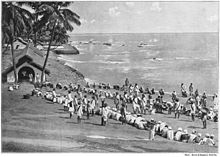British Empire[edit]

Penal colony in the
Andaman Islands,
British Raj (c. 1890s)
With the passage of the
Transportation Act 1717, the British government initiated the
penal transportation of
indentured servants to
Britain's colonies in the Americas, although none of the North American colonies were solely penal colonies. British merchants would be in charge of transporting the convicts across the Atlantic to the colonies where they would be auctioned off to planters. Many of the indentured servants were sentenced to seven year terms, which gave rise to the colloquial term "His Majesty's Seven-Year Passengers".
[1][2][3][4] It is estimated that between 1718 and 1776 about 30,000 convicts were transported to at least nine of the continental colonies, whereas between 1700 and 1775 about 250,000 to 300,000 white immigrants came to the mainland of North America as a whole. More than two-thirds of these felons were transported to
the Chesapeake to work for
Southern landowners; in Maryland, during the thirty years before 1776, convicts composed more than one-quarter of all immigrants.
[5] However, it is commonly maintained that the vast majority of felons taken to America were
political criminals, not those guilty of social crimes such as theft; for example, it was noted of Virginia that "the crimes of which they were convicted were chiefly political, and the number transported for social crimes was never considerable."
[6] The
colony of Georgia, by contrast, was planned by
James Oglethorpe specifically to take in
debtors and other social criminals. Oglethorpe referred to them as "the worthy poor" in a philanthropic effort to create a rehabilitative colony where prisoners could earn a second chance at life, learning trades and working off their debts.
[7][8] The success of Oglethorpe's vision is debated.
[9]
When routes to the Americas closed after the outbreak of
American Revolutionary War in 1776, British prisons started to become
overcrowded.[
citation needed] Since immediate stopgap measures proved themselves ineffective, in 1785 Britain decided to
use parts of what is now known as Australia as de jure penal settlements, becoming the first colonies in the British Empire founded solely to house convicts. Leaving Portsmouth, England on 13 May 1787, the
First Fleet transported the first ~800 convicts and ~250 marines to Botany Bay.[
citation needed] Between 1788 and 1868, about 162,000
convicts were transported from
Great Britain and
Ireland to various
penal colonies in Australia.
[10] Australian penal colonies in late 18th century included
Norfolk Island and
New South Wales, and in early 19th century also
Van Diemen's Land (
Tasmania) and
Moreton Bay (Queensland).[
citation needed]





